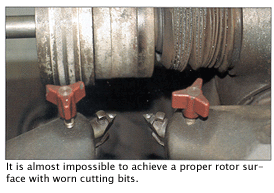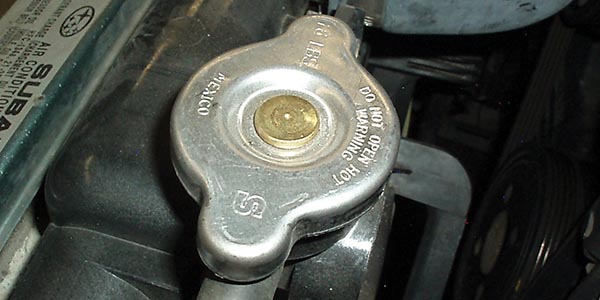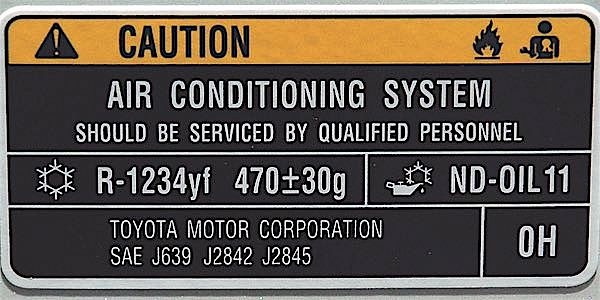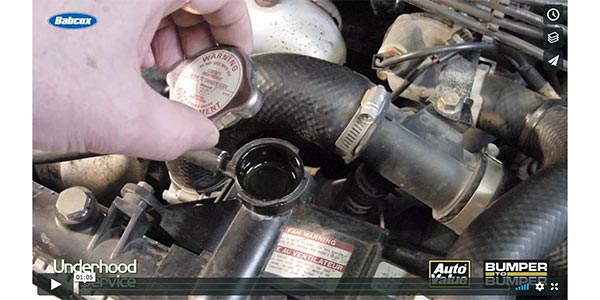More often than not, many rotors today are being replaced when the brakes are relined – and some motorists are complaining that new rotors aren’t really necessary. Unless a rotor is worn down too far to be safely resurfaced or has cracks, deep grooves, severe rusting, hard spots or other structural defects, resurfacing can usually restore the friction surface on worn rotors to like-new condition. So why are so many rotors being replaced?
The answer, I think, is two-fold. Part of the answer has to do with customer satisfaction and reducing comebacks. Regardless of what a brake job ends up costing, the one thing you don’t want is noisy brakes or a braking problem that results in a comeback and an unhappy customer. A comeback is work you have to do over (possibly at your own labor and expense), and an inconvenience for both you and your customer. If rotors are not resurfaced properly or if the rotors have too much run-out, the customer is going to feel it every time he steps on the brake pedal. So that’s one reason for replacing rotors. New rotors reduce the risk of improper surface finish and too much runout (at least in theory).
The second part of the answer involves money. The price of many aftermarket rotors has fallen drastically in recent years due to the availability of inexpensive rotors from China and elsewhere. Quality remains an issue with some of these rotors, but the price is so attractive that some installers can’t resist the temptation to use them – especially if they don’t have a lathe and have been sending their rotors out for resurfacing. For them, it’s faster and easier to simply replace the rotors than to have somebody else resurface the rotors.
Another reason why rotors are often replaced has to do with the quality of the OEM rotors. Though most OEM rotors are top quality, some do not seem to hold up as well as others. We’ve seen a lot of OEM rotors with surface pitting, hard spots and cracks at relatively low mileages (30,000 to 50,000 miles).
 We’ve also seen some severe rusting on some rotors, particularly late-model GM rotors. GM reportedly deleted chromium from their rotor alloy to reduce cost – and ended up reducing the rotor’s resistance to rusting. Oh well….
We’ve also seen some severe rusting on some rotors, particularly late-model GM rotors. GM reportedly deleted chromium from their rotor alloy to reduce cost – and ended up reducing the rotor’s resistance to rusting. Oh well….
We’ve also seen some vehicles with rotor runout problems (Chevy Malibu to name one). Resurfacing the rotors on the vehicle with an on-car lathe can virtually eliminate runout problems, but it requires investing in an on-car lathe. Some installers tell us it’s cheaper and easier just to replace the rotors. But if the runout is in the hub, new rotors won’t make any difference! They will either have to be cut on the car, or shimmed to correct the runout.
Several OEM engineers we’ve heard speak on this subject say OE rotors are typically designed to last two or even three pad replacements. Many do, but just as many do not.
We’ve also heard reports that some OEM passenger car rotors are now much thinner than they used to be to save weight, which also shortens the useful life of the rotors. The impression we now have is that some OEM engineers see rotors as disposable parts that should be replaced when the pads wear out. True or false, time will tell.
At the same time, some OEMs are actually increasing the size and thickness of their rotors to extend life. Chrysler has done just that on their Dodge Ram trucks. The brake pads are reportedly lasting over 50,000 miles on many Ram trucks, and the rotors are still good for another set of pads.
Rotor life can suffer, though, when overly abrasive pads are installed on a vehicle. Some aftermarket friction materials have been accused of being too aggressive and causing rapid rotor wear. If used on a vehicle with typical SAE G3000 gray cast iron rotors, highly abrasive pads will often cause the rotors to wear unevenly resulting in thickness variations that cause a pedal pulsation (brake judder) when the brakes are applied. They will wear rapidly and create variations in thickness.
WHEN GOOD ROTORS GO BAD
Rotors are supposed to outlive pads. But excessive runout, uneven wear, the appearance of hard spots and/or heat damage (cracking, glazing and discoloration) can make good rotors go bad.
A brake pedal pulsation or shudder is one of the most common symptoms that indicates rotor trouble. The cause may be too much runout in a rotor and/or variation in the thickness of the rotor. Runout occurs when the rotor wobbles as it rotates. This may be due to runout in the hub, runout in the way the rotor was originally machined, rust or dirt between the rotor and hub, or uneven torquing of the lug nuts that cause distortion in the rotor and hub (which is why lug nuts should always be tightened to specifications with a torque wrench, not an impact gun).
Some vehicles are much more sensitive to runout than others. Generally speaking, the lighter the vehicle and the lighter the suspension, the more sensitive it is to rotor runout. The latest OEM service specifications typically call for .002 to .003 inch of lateral runout. This can be measured by placing a dial indicator against the face of the rotor and turning the rotor. If you see more than the allowed amount of movement in the dial indicator, the rotor and/or hub may have too much runout for smooth braking.
Exceptions to this rule are 1997-2002 Chevrolet Malibu, 1997-1999 Olds Cutlass, 1999-2002 Olds Alero and 1999-2002 Pontiac Grand Am models. On these vehicles, GM allows only .0015 inch of lateral runout!
Most service specifications also say there should be no more than .001 inch of variation in rotor thickness – which isn’t much. But checking a rotor for such subtle variations in thickness isn’t easy because you have to measure thickness at a dozen or more equally spaced locations around the rotor. Even then, you may not be sure of your measurements because small pits and grooves in the rotor surface can affect the results.
The bottom line here is this: if a customer’s vehicle has a pedal pulsation, the rotors needs to be resurfaced or replaced. You also need to measure rotor runout on the vehicle to determine if the problem is the rotor or the hub so the appropriate corrections can be made.
Most rotors today are manufactured with .0005 to .001 inch of total runout. Likewise, most hubs should have less than .002 inches of runout. But tolerances can sometimes stack up creating too much total runout in the rotor and hub when the parts are assembled.
RUNOUT FIXES
If a rotor has too much runout, use a dial indicator to measure the amount of runout on the mounting face of the hub with the rotor removed. Mark the high spot on the hub and try re-indexing the position of the rotor on the hub to reduce runout.
If that doesn’t work, you can do one of several things to reduce runout:
Replace the hub (expensive) if the hub is the problem;
Install a tapered shim between the hub and rotor to offset the runout
and correct it;
Replace or resurface the rotor if the rotor is the problem; or
Resurface the rotor on the hub using an on-car lathe.
The main advantage of cutting rotors in place is that an on-car lathe cuts the rotor in the same plane that it rotates. This virtually eliminates runout and allows the rotor to run true. But it does require an on-car lathe and some training on how to set it up and use it properly. High end on-car lathes have an automatic setup procedure that makes them quick and easy to use.
The same results can be achieved using a conventional bench lathe, but it requires a multi-step process. First you have to measure and mark the point of maximum runout with the rotor on the vehicle. Then you have to mount the rotor on the lathe arbor and attempt to duplicate the same amount of runout on the lathe. Then you can cut the rotor true and remount it on the car in the same index position as before – and hopefully the runout will be gone.
SURFACE FINISH IS IMPORTANT, TOO
The surface finish on the rotors is also extremely important because it affects the friction characteristics of the brakes, pad seating, break-in, wear and noise. Most new OEM rotors today have a surface finish between 30 and 60 inches RA (roughness average), with many falling in the 40 to 50 RA range. Some OEM specifications say that anything less than 80 RA is acceptable.
It’s almost impossible to see or even feel much of a difference between an 80 RA finish and a 40 RA finish. But such differences can and do affect brake performance – and smoother is always better. So whether you are refinishing rotors on a lathe or replacing them with new ones, the surface finish should be within specifications for best results.
RESURFACE OR REPLACE?
The need for resurfacing depends on the condition of the rotors. In cases where a low mileage vehicle is having its first brake job, you may not have to do anything to the rotors provided they are in relatively good condition and show little wear or grooving. But in high mileage vehicles and those where the rotors are heavily worn, grooved or heat checked, resurfacing or replacement will be necessary.
If you can feel the grooves with your fingernail, the rotor is probably too rough and should be resurfaced or replaced.
No rotor should be resurfaced until you’ve measured its thickness with a micrometer. A rotor must be replaced if it is worn down to minimum specifications or the discard thickness, or cannot be resurfaced without exceeding the minimum “machine to” specification. These specifications are usually cast or stamped on the rotor, and can also be found in brake repair manuals. The specification allows for a certain amount of wear to occur before the rotor reaches the end of its service life. Thin rotors are dangerous because they absorb less heat and are more vulnerable to cracking and catastrophic failure.
A bad rotor can be replaced individually if needed, but usually rotors are replaced in pairs to keep the wear on left and right brakes the same.
DON’T MESS WITH HARD SPOTS
Rotors should also be replaced if they have hard spots. Resurfacing will temporarily restore flatness and the surface finish, but most hard spots extend deep into the metal and will return within a few thousand miles of driving. Hard spots cause uneven wear that results in pedal pulsations when the brakes are applied.
Rotor replacement is also required if the rotors are cracked (more than minor heat checking on the surface) or damaged, or are severely corroded. If the channels between the cooling ribs are obstructed with rust scale, the rotors won’t cool very well and should be replaced.
RESURFACING TIPS
Use the shallowest possible cut to extend the rotor’s life.
Make sure the rotor is properly supported and mounted squarely on the lathe arbor to minimize runout.
If you are resurfacing a “composite” rotor (lightweight rotors that have a stamped steel center hat), special adapters or oversized bell caps are required to support the rotor so it doesn’t distort or flex.
Use a vibration dampener to reduce noise and tool chatter.
Use sharp lathe bits and a slow feed rate to produce a high-quality finish. Using too high a feed rate will leave a rougher finish. On bench lathes, a spindle speed of 100 to 150 rpm with a cross-feed rate of .002 in. to .005 in. per revolution should produce a smooth high quality rotor finish.
ROTOR REPLACEMENT TIPS
If you find it necessary to replace bad or worn out rotors with new ones, do not “clean them up” on your lathe before they are installed. New rotors are machined to specifications and are ready to install out of the box. No further resurfacing is necessary. Turning new rotors reduces their thickness and shortens their service life – and may create runout problems that were not there before you turned them!
For best results, replace original equipment rotors with ones that are the same or better. Premium quality rotors meet or exceed all OEM specifications – something which is not true of many economy rotors.
Premium rotors typically use the same casting configuration as the original (same number of cooling ribs between the faces and same pattern). Vehicle manufacturers use different cooling rib configurations to “optimize” cooling for specific vehicle applications and to reduce harmonics that contribute to brake noise. If rotors with a different rib design or configuration are installed, it may create cooling and/or noise problems.
Most economy rotors use a “standard” cooling fin configuration because it simplifies the casting process and consolidates part numbers. But the trade-off may be reduced cooling performance. If an OEM rotor has 37 ribs and an economy rotor has only 32, cooling may be reduced 8 to 10 percent. This can make the rotors run hotter, which in turn shortens pad life. Laboratory tests have also shown that some economy rotors are much noisier than OEM rotors or premium replacement rotors (85 decibels versus 50 decibels).
The metallurgy of replacement rotors is also important. The metallurgical properties of the iron determine the rotor’s strength, noise, wear and braking characteristics.
The rate at which iron cools in a mold must be closely controlled to achieve the correct tensile strength, hardness and microstructure. If a rotor is too soft, it will wear rapidly. If a rotor is too hard, it is more likely to crack. If harness is uneven, the rotor will wear unevenly or develop hard spots that cause a pedal pulsation. These are all important differences that affect brake performance and rotor life, but they are differences you can’t see with the naked eye. A cheaply made rotor looks the same as a premium rotor.
Finally, if you are replacing rotors, should you replace troublesome composite rotors with solid cast rotors? Cast rotors are cheaper, and are more rigid than composite rotors. But the center hat section of a solid cast rotor is thicker and changes the steering geometry (scrub radius and toe alignment) slightly. This may or many not affect steering and handling on some vehicles. For now, some OEMs (GM) still recommend replacing same with same while others (Ford) say its OK to replace composite with cast.









 We’ve also seen some severe rusting on some rotors, particularly late-model GM rotors. GM reportedly deleted chromium from their rotor alloy to reduce cost – and ended up reducing the rotor’s resistance to rusting. Oh well….
We’ve also seen some severe rusting on some rotors, particularly late-model GM rotors. GM reportedly deleted chromium from their rotor alloy to reduce cost – and ended up reducing the rotor’s resistance to rusting. Oh well….



